Field Day 2022
June 25 - 26 , 2022
Prologue: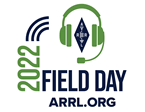
The most popular operating event sponsored by the Amateur Radio Relay League is the annual Field Day event. With the waning of the global COVID-19 pandemic, ham radio activities are ramping up with vigor. Club meetings are being well attended and hamfests are reappearing on the calendar. Larger events such as the ARRL Xenia / Dayton Hamvention are being heavily attended. The expectation then for Field Day is that everyone would start "taking it to the field" !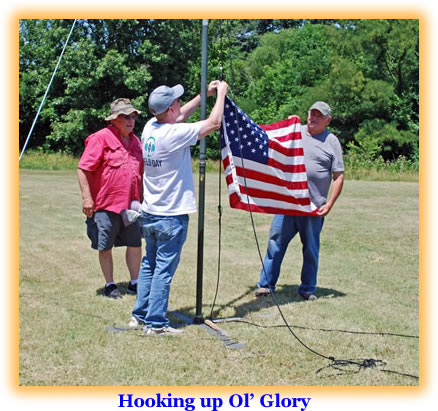
In the wake of the previous two year's of modified pandemic rules, the ARRL again met to review the rules for this Field Day. They sent out questionnaires looking for what the membership would like to see as set rules. There was little surprise in that they eliminated the high power category and made the maximum output power at 100 watts. The surprise was that the ARRL kept the 1D home station rule that was enacted during the height of the pandemic. This allowed home stations to contact other home stations for points. This was not allowed prior to the pandemic and made Field Day a unique operating event. Home stations are again allowed to submit their scores as both individuals and as an affiliated club member where their score would be added to the club's overall score.
Over this past year, Reelfoot Amateur Radio Club gained some new members but also lost some membership. The Clayton's have relocated to the Carolina east coast where they will be living on their nice sailboat ! So, it was decided to again run Field Day as a 2A entry. New member Patrick KO4HEX acquired Steve KK4NNH's very nice Kenwood TS-590S and this became our Get On The Air (GOTA) station once again.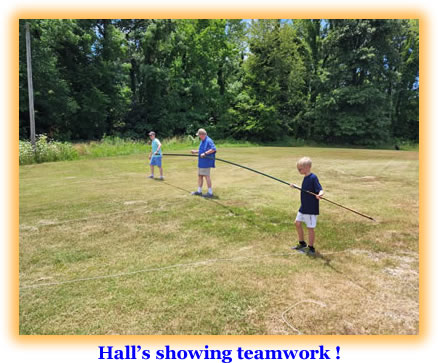
In the last couple years, the digital modes, particularly FT8, have been the most popular on the bands. With the expectation that this would continue, large gain antennas would not be necessary and this would greatly reduce the labor to set them up and tear them down. Last year's event saw every station on the digital modes. The one thing that became apparent while "in the field", was the need for synchronizing time across all computers as these modes require accurate time to within one second. During the "off season", Jamie WB4YDL constructed a GPS-based NTP time server from an ham radio Arduino project book. The hope was that this would allow all computers to be networked to the same exact time. Well, something about the "best laid plans of mice and men" ...
With the 1D home station rule set in stone, we had one such station this year. Phil N4PWG declared he would run from home and also be present at the shop for bonus points as a served agency official. Also, last year we saw a tremendous influx of youth bonus points. We all hoped that that would recur again this year. 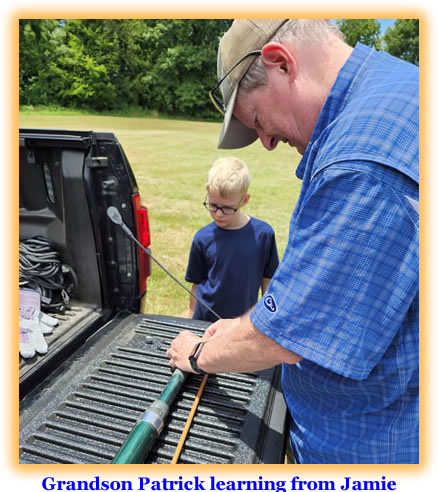 The nice thing about the newer digital modes is that they are relatively easy to teach to newcomers.
The nice thing about the newer digital modes is that they are relatively easy to teach to newcomers.
The goal on the radio is to make contact with as many stations as possible on each of the contest-allowing ham radio bands - 80, 40, 20, 15, and 10 meters on HF. Another side goal is to make contact with as many North American sections as possible. There are 84 possible sections encompassing the continental United States, Canada, Hawaii, Alaska, the Pacific territories, the US Virgin Islands, and Puerto Rico.
Setup:
The venue for this year's event was again at Glenn N4MJ's shop located between South Fulton and Martin, TN. For several years this has been just perfect for our club for any activation that we wished to engage. So, on the Thursday prior to the Field Day weekend, we gathered at the shop and setup our computers and radios. This went very smoothly.
This year, Patrick KO4HEX headed up the GOTA station with his Kenwood TS-590S radio. This station would run with Glenn's call sign of N4MJ and became a popular station. It even ended up making a few phone contacts.
For class 2A, the two transceivers consisted of Jamie WB4YDL's Elecraft K3S radio and Michael AK4VU's very nice Kenwood TS-480HX transceiver.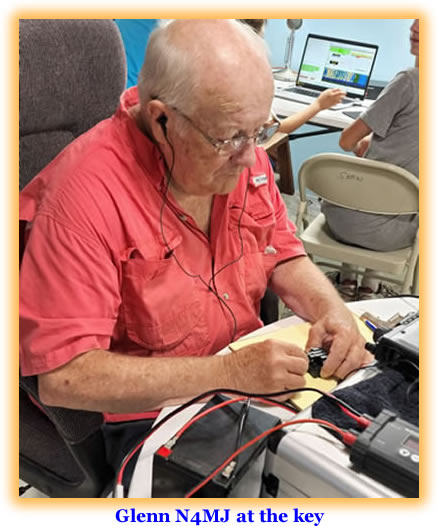 Each radio had digital interfaces and each of these two stations had laptop computers interfaced running networked N3FJP Field Day logging software as well as up-to-date WSJT-X and flDigi software.
Each radio had digital interfaces and each of these two stations had laptop computers interfaced running networked N3FJP Field Day logging software as well as up-to-date WSJT-X and flDigi software.
The "free" VHF station would again consist of Jamie WB4YDL's Yaesu FT-847 transceiver and would have 2 meter, 70 centimeter, and 6 meter antennas attached. Last year, the satellite array, along with the Airspy SDR receiver, was successful in snagging the 100 point satellite QSO bonus. New control cables made by Glenn N4MJ were run through the PVC tubes to make cabling up the rotator easier. Most linear transponder satellites operate to receive on the 70 cm. band, and transmit on the 2M band. SatPC32 control software as well as SDR Console was configured to control these two simultaneously to follow Doppler changes in frequency as the satellite passed overhead. The antennas (simple Arrow yagis for 2M and 70 cm) were mounted on a PVC crossboom using a Yaesu G-5500 alt-az rotator system. With the increase in solar activity with solar cycle 25 ramping up, it was hoped that 6 meters would be a productive band. This station is also responsible for a LOT of points gathered with Winlink radio email traffic and messages to the section manager and section emergency coordinator.
The following afternoon, we met to raise the antennas we would use. For HF, this consisted of an inverted-L antenna for the Elecraft K3S station and an offset-center dipole (OCD) for the Kenwood TS-480HX station. We also had a longer version of the OCD that would normally be our "Wildcard" antenna. These antennas are very simple antennas and took little time to deploy. The GOTA antenna would be the small Mosley triband yagi on a push-up mast and the 6M antenna would also be a small yagi on the same mast. 2M activity would borrow the satellite Arrow yagi for such things as Winlink traffic.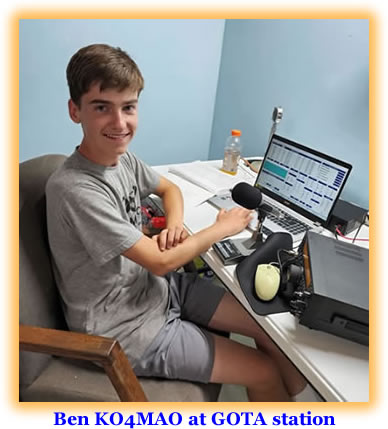
The Operation:
Saturday morning was predictably hot and humid. But because of our great facility, everyone was in air conditioned comfort and stayed that way for the entire event.
This year, Patrick KO4HEX gave the educational bonus presentation as we all munched on sandwiches prior to "kick off". He gave a very interesting presentation on the winding of a toroid and brought extra wire and toroids for anyone to wind their own. A 49:1 transformer toroid is a key component of the popular end-fed half wave wire antenna. During this time, we transferred power to the generator and turned on radios and computers. It was here that we saw that the computers were not in time sync. The NTP server that was made by Jamie WB4YDL was tried but it could not acquire a lock on the GPS satellites from within the shop. Patrick, after completing his presentation, made his cell phone a hotspot for Internet access, and each computer was able to get time synchronized. Even then, we had to take each computer outside where Patrick was able to finally get a hotspot going. The shop is a perfect example of a Faraday cage !
Glenn N4MJ brought over his Yaesu FT-817 QRP radio and it was configured for solar power. Michael AK4VU had not arrived yet, so we kept that station off line so Glenn could take care of the natural power QSO's using solar power on 5 watts CW. These would be the only CW QSO's made during Field Day.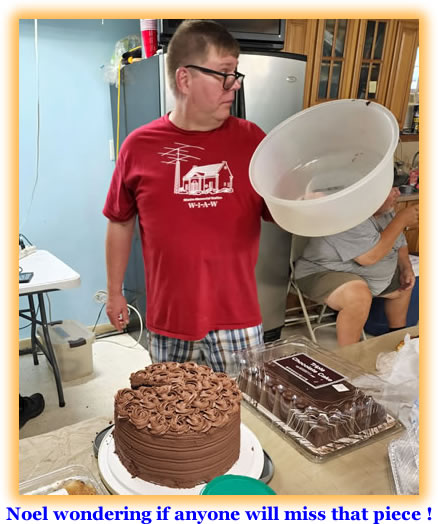
At the appointed time of 1 o'clock, the bands exploded to life with signals from all over North America. Glenn N4MJ easily took care of the natural power CW QSO's - good for 100 points. Harold KJ4FTM also got to work on 15 meter FT8 at the Elecraft K3S station. Jamie WB4YDL activated 6 meter FT8 operation.
Band conditions were not as good as last year when 10 meters was in great shape. However, 15 meters was productive and 20 meters was the money band. Michael AK4VU made it in and activated his Kenwood TS-480HX station. He had none of the technical issues that plagued his station last year and this paid off with good production.
Bonus points were beginning to pile up ! Jamie WB4YDL was able to copy the W1AW Field Day bulletin the night before and he also posted to the social media platform MeWe where our club has a presence. Also, a slight modification of Ben KO4MAO's last year's poster made it THIS year's public information display. Jamie added a picture of the day's solar observation with visible sunspots and added this year's Field Day logo. The Union City Messenger had a nice write-up on our club's operation and this was submitted by our president Noel KJ4UNX. Noel also served as our safety officer and of course was our Super Chef handling the cookout duties with great burgers on the grill.
Also this year, we were honored to have present for our elected official visit both Benny McGuire, Obion County Mayor, and Ralph Puckett, Obion County Commissioner - good for another 100 points. 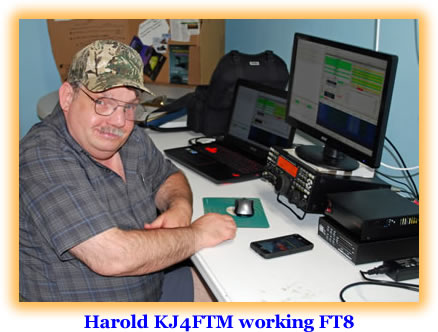 When 6 meters was slowing down, Jamie WB4YDL would switch to 2 meters and activate Winlink using AX.25 packet and Roger's node KJ4AJP-10 located in Martin. Properly formatted Radiogram messages were sent via Winlink to both our ARES Section Manager and ten other individual Field Day participants. This was all good for 200 more bonus points. Actually, about 5 times as much Winlink traffic was handled this year as last year adding to the emergency preparedness aspect of the operation.
When 6 meters was slowing down, Jamie WB4YDL would switch to 2 meters and activate Winlink using AX.25 packet and Roger's node KJ4AJP-10 located in Martin. Properly formatted Radiogram messages were sent via Winlink to both our ARES Section Manager and ten other individual Field Day participants. This was all good for 200 more bonus points. Actually, about 5 times as much Winlink traffic was handled this year as last year adding to the emergency preparedness aspect of the operation.
The youth involvement was off the chart this year ! We had 12 kids less than 18 years old attend and 5 of them actually made contacts ! This easily achieved the youth bonus and Ben KO4MAO and Patrick KO4HEX helped to mentor these young attendees. Also, Michael AK4VU's little buddy, Jacob really came to play and made a tremendous number of QSO's.
Besides Jamie WB4YDL, Michael AK4VU, and Glenn N4MJ, we had Harold KJ4FTM, Michael Snow N4EBA, Patrick KO4HEX, Ben KO4MAO, Phil N4PWG and Noel KJ4UNX as our on-site licensed operators. We had a total of 29 signatures on the visitor sign-in sheet.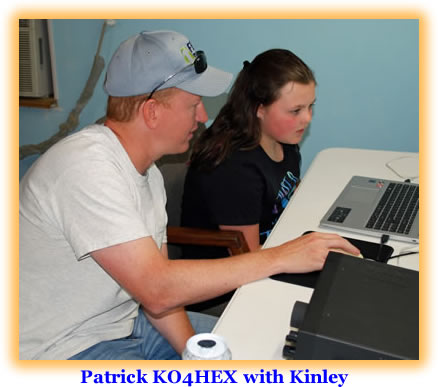
Jamie WB4YDL was able to log a satellite QSO using the same setup as last year. This involved hearing and seeing the signals through an Airspy SDR and its software and transmitting using the Yaesu FT-847. Both Doppler shifts were interlocked and controlled by the SatPC software. This year, Jamie was able to make contact with a station in Alabama using the Chinese satellite XW-2C. There was quite a bit of "local QRM" and the audio wasn't particularly strong, but with the help of Michael's Heil headset, the connection was made and it was in the log for another 100 points !
The food provided for all attendees was fabulous ! Noel provided great grilled burgers, Ms. June, Jamie WB4YDL's XYL provided sub sandwiches and other munchies, and Glenn N4MJ provided pizzas for our setup meeting. Harold KJ4FTM again showed off his bakery talent as he made his famous chocolate cake ! Many others contributed sides and drinks to keep us all fed and hydrated. All was much appreciated !
An interesting aside was the setup by Jamie and Harold of a Coronado solar telescope !! This produced astounding views of the solar disk together with easily visible prominences and sunspots. This added to the flavor of the rising activity on the sun to give our hobby its pizzazz !
Finally, at 1 PM Sunday, the operations ceased and another Field Day was in the books !
The Results:
So, as the sunspots increase and activity on the bands gets hot, how did this translate for this Field Day ? Here are the line scores :Score Summary:
| CW | Digital | Phone |
Total | |
|---|---|---|---|---|
| Total QSO's | 5 |
1003 |
5 |
1013 |
Band / Mode QSO Breakdown:
| CW | Digital | Phone | Total | |
|---|---|---|---|---|
| 80M | 0 |
167 |
0 |
167 |
| 40M | 0 |
157 |
0 |
157 |
| 20M | 0 |
193 |
0 |
193 |
| 15M | 5 |
17 |
0 |
22 |
| 10M | 0 |
4 |
0 |
4 |
| 6M | 0 |
51 |
0 |
51 |
| SAT | 0 |
0 |
1 |
1 |
| GOTA | 0 |
414 |
4 |
418 |
| TOTAL | 5 |
1003 |
5 |
1013 |
The bonus point total this year was 2070 points which was a nice improvement thanks again to the youth involvement and the GOTA station contribution. We made up 240 points from last year thanks largely to the GOTA station.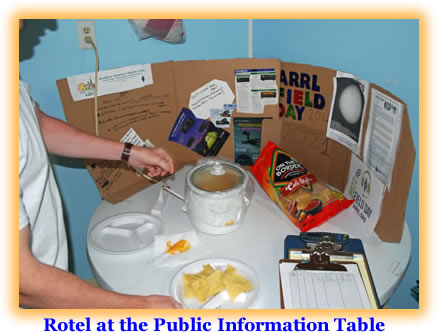
The total QSO score after the power multiplier (x2) came out to 4042 points an 858 point improvement. Most QSO's made were 2 point digital QSO's. There is no question that the fascination of FT8 has been established and remains strong. The other mode making a big contribution was the faster FT4 mode. Only Glenn N4MJ made CW QSO's which are also 2 points each. The upper bands did not show up as well as last year. The huge improvement was on 20 M where there were NO digital QSO's last year ! Also keeping pace were both 40M and 80M. The total submitted score was 6112 points for Reelfoot Amateur Radio Club in the class 2A category. This was an over 1000 point improvement over the previous year and under the same rules.
Our 1D station Phil N4PWG submitted a nice score of 722 points (also a nice improvement from last year). The combined total score for Reelfoot Amateur Radio Club for Field Day in class 2A this year comes to 6834 points. This is a nearly 1200 point improvement over last year's score. The only times Reelfoot Amateur Radio Club have reached this stratosphere in score is when we were running 3A, that is with one more active HF station.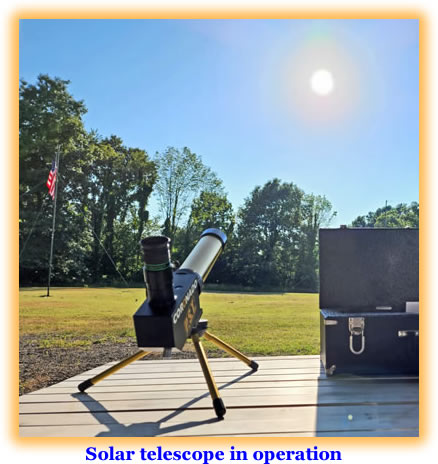 The year 2020 was an anomaly 2A year where we scored 7776 points with several 1D stations under COVID-19 rules. We will see how this score stacks against our peers.
The year 2020 was an anomaly 2A year where we scored 7776 points with several 1D stations under COVID-19 rules. We will see how this score stacks against our peers.
Epilogue:
Jamie WB4YDL had recent foot surgery this year and was a bit hobbled, however, with everyone pitching in and doing their part, setup and take down went very smoothly and safely. The camaraderie of our small group was excellent ! More and more youthful visitors are being seen and some in the log. The GOTA station performed magnificently and made a record number of QSO's. We had 5 operators on this station that qualified for double bonus points, including Patrick KO4HEX who maxed out the bonus points allowed.
Photography for this event was provided by Michael AK4VU, Patrick KO4HEX and Jamie WB4YDL .
The Shop at the QTH of Glenn N4MJ was once again the perfect Field Day location and the club members owe many thanks to Glenn and XYL Linda for a wonderful experience. Thanks also go to our XYL's who kept us fed and hydrated. The full Field Day results are published in the December issue of QST.
Soapbox:
Patrick KO4HEX :
FD 2022 was a great success. 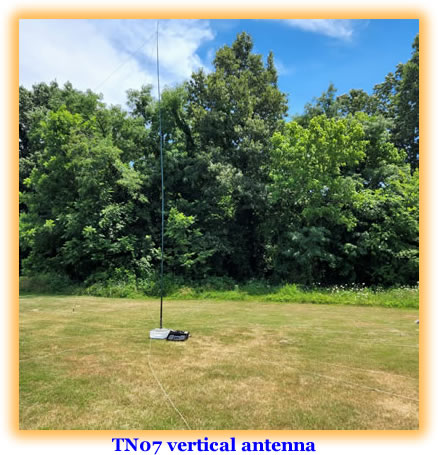 The weather didn't turn out too hot on setup days. Sunday it was fairly humid, but nothing compared to last year. We set up and tore down in record time this year with the OCF, the inverted L, and the 2M station. Jamie WB4YDL, was able to push through on his ankle through setup and take down. He was also able to successfully make the satellite contact.
The weather didn't turn out too hot on setup days. Sunday it was fairly humid, but nothing compared to last year. We set up and tore down in record time this year with the OCF, the inverted L, and the 2M station. Jamie WB4YDL, was able to push through on his ankle through setup and take down. He was also able to successfully make the satellite contact.
We had 29 people in attendance with several youth operators included. Patrick KO4HEX was able to provide the education on winding a 49:1 toroid. Noel KJ4UNX was the grill master yet again this year. The burgers were great as always. Harold KJ4FTM brought in the chocolate cake again as well, which is quickly becoming a favorite.
Glen, N4MJ was able to make our CW contacts and Ben, KO4MAO was able to make a few SSB contacts, although the conditions for ssb were pretty rough. The mode of choice this year was digital, specifically FT4. The bands really opened up from 6M all the way down to 80 throughout the day and night.
As the sun went down, Jamie WB4YDL, brought his solar telescope and we were able to view sun spots on the Sun, and what looked to be solar bursts around the edge of the Sun. The view was stunning.
Overall, I believe this was one of the club's most successful Field Days, especially operating as 2A. As the band continues to open up as we progress through cycle 25, next year should be even better!
Glenn N4MJ :
FD is a time when the club comes together to partake in a challenging activity. This year, the challenges seemed to come together easier than past FDs. Teamwork was key.
Everyone knew what had to be done and jumped to it right away. Jamie and key Ops took care of setting up the computers/networking quickly. Antenna raising was well coordinated; antennas went up without a hitch and in a timely manner. 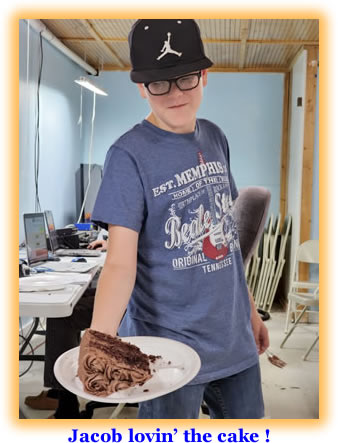
OTA activity went equally smooth. Ops knew what needed to be done and did it without delay.
GOTA activity was headed up by Patrick, KO4HEX, and Ben, KO4MAO. All the visiting youngsters enjoyed making contacts and seeing the digital interface work. Hopefully, some were impressed enough to pursue a license.
Jamie, chief coordinator of everything, did his usual operating antics – sometimes operating two stations simultaneously – VHF/UHF (6 meters and UHF satellites) & HF. Many points were gained via the VHF and Satellite contacts.
The only CW operation was the initial 5 contacts via alternate power by Glenn, N4MJ using a solar panel and battery combo with the FT-817ND and N3ZN micro key.
Operators Mike, AK4VU, Mike, N4EBA, Harold, KJ4FTM, Noel, KJ4UNX, Patrick, KO4HEX, Jamie, WB4YDL, Ben, KO4MAX, Glenn, N4MJ maintained the 24 hour operating period.
This was Ben’s, KO4MAO, second year to participate. This year he learned how to install the all-band 40 meter OCF dipole. He learned how to raise and align and guy the vertical support. He also learned how to tie several knots used during the installation.
This was also Patrick’s, KO4HEX, second year to participate. His team effort and support was greatly appreciated. When not operating the GOTA station, he was working one of the other stations. His help with the generator set-up and removal was appreciated more than he knows. Thanks again Patrick.
Noel, KJ4UNX, grilled the burgers. Multiple folks contributed food and to them a BIG THANK YOU goes. Who can forget that tall chocolate cake made & brought by Harold, KJ4FTM?
The only negative thing I can say about FD 2022 was the expenses. Yep, food and fuel costs considerably more than usual but we got’er done.
In conclusion there are a number of ways to evaluate the success of FD ops. Interest, coordination, cooperation, participation, visitors, operating activity, GOTA activity, equipment availability/activity, and leadership come to mind. From this OM’s chair I would give an A plus to all the above for FD 2022.
Many thanks to all for making FD 2022 a great success from beginning to end.
73 de n4mj//glenn
See you on Field Day 2023 !
When all else fails ... Amateur Radio.











